National Institute of Oceanography and Applied Geophysics - OGS, Division of Oceanography
Type of resources
Available actions
Topics
INSPIRE themes
Keywords
Contact for the resource
Provided by
Years
Formats
Representation types
Scale
Resolution
-
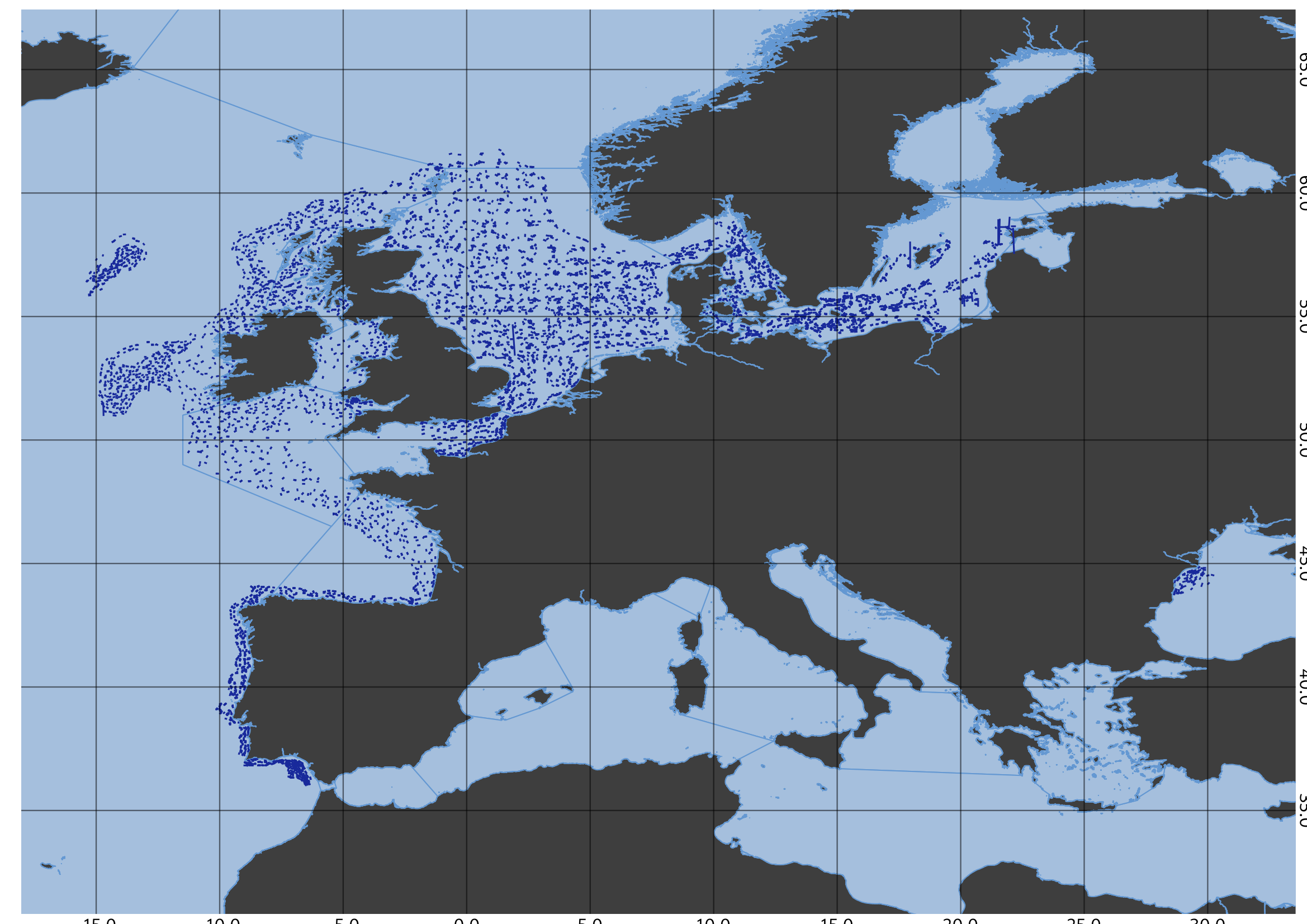
EMODnet Chemistry aims to provide access to marine chemistry data sets and derived data products concerning eutrophication, ocean acidification, contaminants and litter. The chosen parameters are relevant for the Marine Strategy Framework Directive (MSFD), in particular for descriptors 5, 8, 9 and 10. The datasets contain standardized, harmonized and validated data collections from seafloor litter. Datasets concerning seafloor litter data are loaded in a central database after a semi-automated validation phase. Once loaded, a data assessment is performed in order to check data consistency and potential errors are corrected thanks to a feedback loop with data originators. EMODnet seafloor litter data and database are hosted and maintained by ‘Istituto Nazionale di Oceanografia e di Geofisica Sperimentale, Division of Oceanography (OGS/NODC)’ from Italy. For seafloor litter, the harmonized datasets contain all unrestricted EMODnet Chemistry data on seafloor litter data, including 12438 CDI records. The temporal range covered is from 2006-10-01 to 2018-08-16. Data are formatted following Guidelines and forms for gathering marine litter data, which can be found at: https://www.emodnet-chemistry.eu/documents/projectdocuments. The harmonized datasets can be downloaded as EMODnet Sea-floor litter data format Version 1.0, which is a csv file, tab separated values. The original datasets can be searched and downloaded from EMODnet Chemistry Download Service: https://emodnet-chemistry.maris.nl/search
-
Water body phosphate - Seasonal Climatology for Po River for the period 1980-2019 on the domain: Lon E12.0-14.0 deg.E, Lat N44.0-46.00 deg.N. Data Sources: observational data from SeaDataNet/EMODNet Chemistry Data Network. Description of DIVA analysis: The computation was done with the DIVAnd (Data-Interpolating Variational Analysis in n dimensions), version 2.7.4, using GEBCO 30sec topography for the spatial connectivity of water masses. A relative correlation length used based on topography gradients and the horizontal correlation length varies from 25 km to 12.5 km. The vertical correlation length (in meters) is: [4.,4.,4.,4.,4.,10.,10.,10.,10.,20.,20.,20.,20.,20.]. Depth range: [0., 2., 4., 6., 8., 10., 15., 20., 25., 30., 40., 50., 60., 70.]. Units: umol/l. The horizontal resolution of the produced DIVAnd maps grids is dx=dy=0.009 degrees (around 975m and 708m accordingly). Additional analysis parameters: The error variance (epsilon2) was set equal to 1. Data weight was reduced near the coasts. Data weighting was applied with the following threshold values: lon=0.03, lat=0.03, depth=2. Threshold value for log transformation=200. Seasons definition: Winter=Jan-Mar, Spring=Apr-Jun, Summer=Jul-Sep, Autumn=Oct-Dec. DOI: 10.6092/jb28-9k33
-
Dissolved inorganic nitrogen (DIN) - Seasonal Climatology for Po River for the period 1980-2019 on the domain: Lon E12.0-14.0 deg.E, Lat N44.0-46.00 deg.N. Data Sources: observational data from SeaDataNet/EMODNet Chemistry Data Network. Description of DIVA analysis: The computation was done with the DIVAnd (Data-Interpolating Variational Analysis in n dimensions), version 2.7.4, using GEBCO 30sec topography for the spatial connectivity of water masses. A relative correlation length used based on topography gradients and the horizontal correlation length varies from 25 km to 12.5 km. The vertical correlation length (in meters) is: [4.,4.,4.,4.,4.,10.,10.,10.,10.,20.,20.,20.,20.,20.]. Depth range: [0., 2., 4., 6., 8., 10., 15., 20., 25., 30., 40., 50., 60., 70.]. Units: umol/l. The horizontal resolution of the produced DIVAnd maps grids is dx=dy=0.009 degrees (around 975m and 708m accordingly). Additional analysis parameters: The error variance (epsilon2) was set equal to 1. Data weight was reduced near the coasts. Data weighting was applied with the following threshold values: lon=0.03, lat=0.03, depth=2. Threshold value for log transformation=200. Seasons definition: Winter=Jan-Mar, Spring=Apr-Jun, Summer=Jul-Sep, Autumn=Oct-Dec. DOI: 10.6092/p8ec-3v81
-
Water body chlorophyll-a - Seasonal Climatology for Po River for the period 1980-2019 on the domain: Lon E12.0-14.0 deg.E, Lat N44.0-46.00 deg.N. Data Sources: observational data from SeaDataNet/EMODNet Chemistry Data Network. Description of DIVA analysis: The computation was done with the DIVAnd (Data-Interpolating Variational Analysis in n dimensions), version 2.7.4, using GEBCO 30sec topography for the spatial connectivity of water masses. A relative correlation length used based on topography gradients and the horizontal correlation length varies from 25 km to 12.5 km. The vertical correlation length (in meters) is: [4.,4.,4.,4.,4.,10.,10.,10.,10.,20.,20.,20.,20.,20.]. Depth range: [0., 2., 4., 6., 8., 10., 15., 20., 25., 30., 40., 50., 60., 70.]. Units: mg/m3. The horizontal resolution of the produced DIVAnd maps grids is dx=dy=0.009 degrees (around 975m and 708m accordingly). Additional analysis parameters: The error variance (epsilon2) was set equal to 1. Data weight was reduced near the coasts. Data weighting was applied with the following threshold values: lon=0.03, lat=0.03, depth=2. Threshold value for log transformation=200. Seasons definition: Winter=Jan-Mar, Spring=Apr-Jun, Summer=Jul-Sep, Autumn=Oct-Dec. DOI: 10.6092/nv0n-4996
-
Water body silicate - Seasonal Climatology for Po River for the period 1980-2019 on the domain: Lon E12.0-14.0 deg.E, Lat N44.0-46.00 deg.N. Data Sources: observational data from SeaDataNet/EMODNet Chemistry Data Network. Description of DIVA analysis: The computation was done with the DIVAnd (Data-Interpolating Variational Analysis in n dimensions), version 2.7.4, using GEBCO 30sec topography for the spatial connectivity of water masses. A relative correlation length used based on topography gradients and the horizontal correlation length varies from 25 km to 12.5 km. The vertical correlation length (in meters) is: [4.,4.,4.,4.,4.,10.,10.,10.,10.,20.,20.,20.,20.,20.]. Depth range: [0., 2., 4., 6., 8., 10., 15., 20., 25., 30., 40., 50., 60., 70.]. Units: umol/l. The horizontal resolution of the produced DIVAnd maps grids is dx=dy=0.009 degrees (around 975m and 708m accordingly). Additional analysis parameters: The error variance (epsilon2) was set equal to 1. Data weight was reduced near the coasts. Data weighting was applied with the following threshold values: lon=0.03, lat=0.03, depth=2. Threshold value for log transformation=200. Seasons definition: Winter=Jan-Mar, Spring=Apr-Jun, Summer=Jul-Sep, Autumn=Oct-Dec. DOI: 10.6092/njvc-n987
-
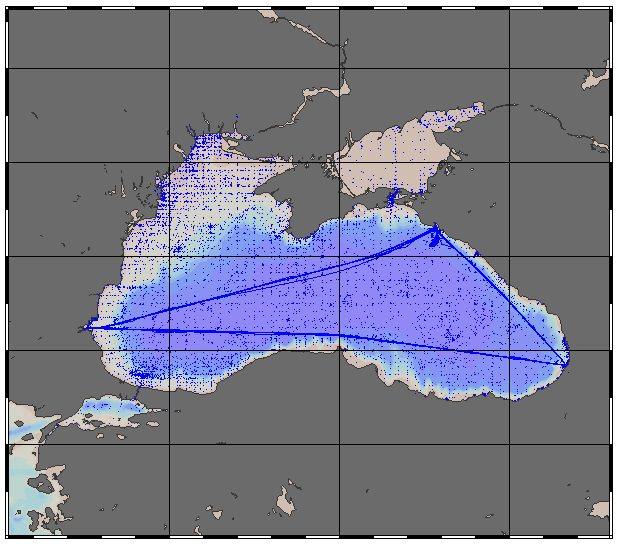
EMODnet Chemistry aims to provide access to marine chemistry data sets and derived data products concerning eutrophication, acidity and contaminants. The chemicals chosen reflect importance to the Marine Strategy Framework Directive (MSFD). ITS-90 water temperature and Water body salinity variables have been also included (as-is) to complete the Eutrophication and Acidity data. If you use these variables for calculations, please refer to SeaDataNet for having the quality flags: https://www.seadatanet.org/Products/Aggregated-datasets . This aggregated dataset contains all unrestricted EMODnet Chemistry data on Eutrophication and Acidity (14 parameters with quality flag indicators), and covers the Black Sea, Sea of Marmara and Sea of Azov with 62704 CDI records. Data were aggregated and quality controlled by 'National Institute for Marine Research and Development 'Grigore Antipa' from Romania. Regional datasets concerning eutrophication and acidity are automatically harvested and resulting collections are aggregated and quality controlled using ODV Software and following a common methodology for all Sea Regions ( https://doi.org/10.6092/9f75ad8a-ca32-4a72-bf69-167119b2cc12). When not present in original data, Water body nitrate plus nitrite was calculated by summing up the Nitrates and Nitrites. Same procedure was applied for Water body dissolved inorganic nitrogen (DIN) which was calculated by summing up the Nitrates, Nitrites and Ammonium. Parameter names are based on P35, EMODnet Chemistry aggregated parameter names vocabulary, which is available at: https://www.bodc.ac.uk/resources/vocabularies/vocabulary_search/P35/. Detailed documentation is available at: https://dx.doi.org/10.6092/4e85717a-a2c9-454d-ba0d-30b89f742713 Explore and extract data at: https://emodnet-chemistry.webodv.awi.de/eutrophication%3EBlackSea The aggregated dataset can also be downloaded as ODV collection and spreadsheet, which is composed of metadata header followed by tab separated values. This spreadsheet can be imported to ODV Software for visualisation (More information can be found at: https://www.seadatanet.org/Software/ODV ). The original datasets can be searched and downloaded from EMODnet Chemistry Download Service: https://emodnet-chemistry.maris.nl/search
-
Water body dissolved oxygen concentration - Seasonal Climatology for Po River for the period 1960-2019 on the domain: Lon E12.0-14.0 deg.E, Lat N44.0-46.00 deg.N. Data Sources: observational data from SeaDataNet/EMODNet Chemistry Data Network. Description of DIVA analysis: The computation was done with the DIVAnd (Data-Interpolating Variational Analysis in n dimensions), version 2.7.4, using GEBCO 30sec topography for the spatial connectivity of water masses. A relative correlation length used based on topography gradients and the horizontal correlation length varies from 25 km to 12.5 km. The vertical correlation length (in meters) is: [4.,4.,4.,4.,4.,10.,10.,10.,10.,20.,20.,20.,20.,20.]. Depth range: [0., 2., 4., 6., 8., 10., 15., 20., 25., 30., 40., 50., 60., 70.]. Units: umol/l. The horizontal resolution of the produced DIVAnd maps grids is dx=dy=0.009 degrees (around 975m and 708m accordingly). Additional analysis parameters: The error variance (epsilon2) was set equal to 1. Data weight was reduced near the coasts. Data weighting was applied with the following threshold values: lon=0.03, lat=0.03, depth=2. Threshold value for log transformation=200. Seasons definition: Winter=Jan-Mar, Spring=Apr-Jun, Summer=Jul-Sep, Autumn=Oct-Dec. DOI: 10.6092/tasv-9066
-
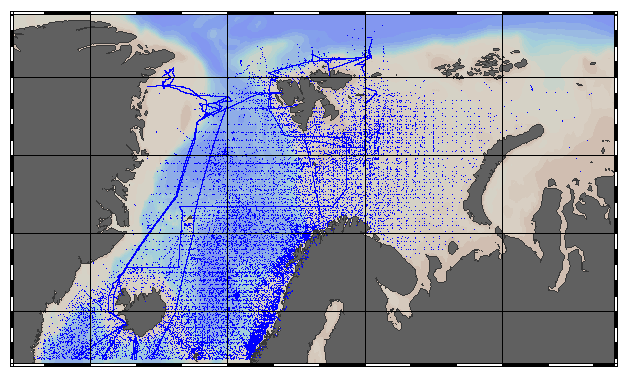
EMODnet Chemistry aims to provide access to marine chemistry data sets and derived data products concerning eutrophication, acidity and contaminants. The chemicals chosen reflect importance to the Marine Strategy Framework Directive (MSFD). This aggregated dataset contains all unrestricted EMODnet Chemistry data on Eutrophication and Acidity (14 parameters with quality flag indicators), and covers the Norwegian Sea, Barents Sea, Greenland Sea and Icelandic Waters with 114721 CDI stations. Data were aggregated and quality controlled by 'Institute of Marine Research - Norwegian Marine Data Centre (NMD)'. Regional datasets concerning eutrophication and acidity are automatically harvested and resulting collections are aggregated and quality controlled using ODV Software and following a common methodology for all Sea Regions ( https://doi.org/10.6092/9f75ad8a-ca32-4a72-bf69-167119b2cc12 ). When not present in original data, Water body nitrate plus nitrite was calculated by summing up the Nitrates and Nitrites. Same procedure was applied for Water body dissolved inorganic nitrogen (DIN) which was calculated by summing up the Nitrates, Nitrites and Ammonium. Parameter names are based on P35, EMODnet Chemistry aggregated parameter names vocabulary, which is available at: https://www.bodc.ac.uk/resources/vocabularies/vocabulary_search/P35/ Detailed documentation is available at: https://dx.doi.org/10.6092/4e85717a-a2c9-454d-ba0d-30b89f742713 Explore and extract data at: https://emodnet-chemistry.webodv.awi.de/eutrophication>Arctic The aggregated dataset can also be downloaded as ODV collection and spreadsheet, which is composed of metadata header followed by tab separated values. This spreadsheet can be imported to ODV Software for visualisation (More information can be found at: https://www.seadatanet.org/Software/ODV ) The original datasets can be searched and downloaded from EMODnet Chemistry Download Service: https://emodnet-chemistry.maris.nl/search
-
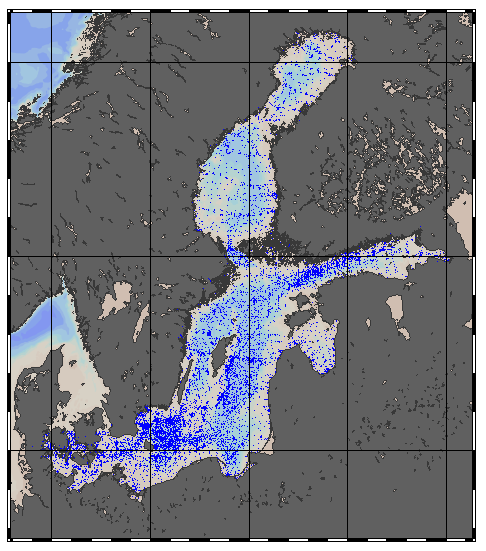
EMODnet Chemistry aims to provide access to marine chemistry data sets and derived data products concerning eutrophication, acidity and contaminants. The chemicals chosen reflect importance to the Marine Strategy Framework Directive (MSFD). ITS-90 water temperature and Water body salinity variables have been also included (as-is) to complete the Eutrophication and Acidity data. This aggregated dataset contains all unrestricted EMODnet Chemistry data on Eutrophication and Acidity (14 parameters with quality flag indicators), and covers the Baltic Sea with 175834 CDI stations (175778 Vertical profiles and 56 Time series). Vertical profiles temporal range is from 1902-08-05 to 2020-10-10. Time series temporal range is from 2010-01-12 to 2016-02-10. Data were aggregated and quality controlled by "Swedish Meteorological and Hydrological Institute (SMHI)" from Sweden. Regional datasets concerning eutrophication and acidity are automatically harvested and resulting collections are aggregated and quality controlled using ODV Software and following a common methodology for all Sea Regions ( https://doi.org/10.6092/9f75ad8a-ca32-4a72-bf69-167119b2cc12). When not present in original data, Water body nitrate plus nitrite was calculated by summing up the Nitrates and Nitrites. Same procedure was applied for Water body dissolved inorganic nitrogen (DIN) which was calculated by summing up the Nitrates, Nitrites and Ammonium. Parameter names are based on P35, EMODnet Chemistry aggregated parameter names vocabulary, which is available at: https://www.bodc.ac.uk/resources/vocabularies/vocabulary_search/P35/ Detailed documentation is available at: https://dx.doi.org/10.6092/4e85717a-a2c9-454d-ba0d-30b89f742713 Explore and extract data at: https://emodnet-chemistry.webodv.awi.de/eutrophication%3EBaltic The aggregated dataset can also be downloaded as ODV collection and spreadsheet, which is composed of metadata header followed by tab separated values. This spreadsheet can be imported to ODV Software for visualisation (More information can be found at: https://www.seadatanet.org/Software/ODV ) The original datasets can be searched and downloaded from EMODnet Chemistry Download Service: https://emodnet-chemistry.maris.nl/search
-
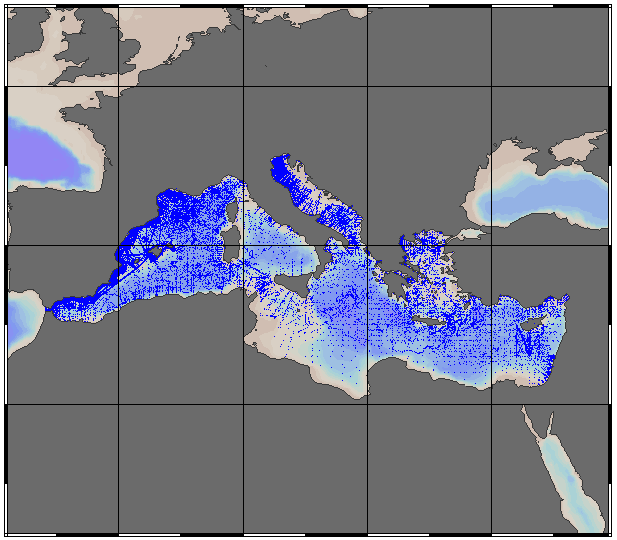
EMODnet Chemistry aims to provide access to marine chemistry data sets and derived data products concerning eutrophication, acidity and contaminants. The chemicals chosen reflect importance to the Marine Strategy Framework Directive (MSFD). ITS-90 water temperature and Water body salinity variables have been also included (as-is) to complete the Eutrophication and Acidity data. If you use these variables for calculations, please refer to SeaDataNet for having the quality flags: https://www.seadatanet.org/Products/Aggregated-datasets . This aggregated dataset contains all unrestricted EMODnet Chemistry data on Eutrophication and Acidity (15 parameters with quality flag indicators), and covers the Mediterranean Sea with 187722 CDI records (180932 Vertical profiles and 6790 Time series). Vertical profiles temporal range is from 1911-08-17 to 2020-10-16. Time series temporal range is from 1974-06-04 to 2018-02-20. Data were aggregated and quality controlled by 'Hellenic Centre for Marine Research, Hellenic National Oceanographic Data Centre (HCMR/HNODC)' from Greece. Regional datasets concerning eutrophication and acidity are automatically harvested and resulting collections are aggregated and quality controlled using ODV Software and following a common methodology for all Sea Regions ( https://doi.org/10.6092/9f75ad8a-ca32-4a72-bf69-167119b2cc12). When not present in original data, Water body nitrate plus nitrite was calculated by summing up the Nitrates and Nitrites. Same procedure was applied for Water body dissolved inorganic nitrogen (DIN) which was calculated by summing up the Nitrates, Nitrites and Ammonium. Parameter names are based on P35, EMODnet Chemistry aggregated parameter names vocabulary, which is available at: https://www.bodc.ac.uk/resources/vocabularies/vocabulary_search/P35/. Detailed documentation is available at: https://dx.doi.org/10.6092/4e85717a-a2c9-454d-ba0d-30b89f742713 Explore and extract data at: https://emodnet-chemistry.webodv.awi.de/eutrophication%3EMediterranean The aggregated dataset can also be downloaded as ODV collection and spreadsheet, which is composed of metadata header followed by tab separated values. This spreadsheet can be imported to ODV Software for visualisation (More information can be found at: https://www.seadatanet.org/Software/ODV ). The original datasets can be searched and downloaded from EMODnet Chemistry Download Service: https://emodnet-chemistry.maris.nl/search
 Metadata catalogue
Metadata catalogue